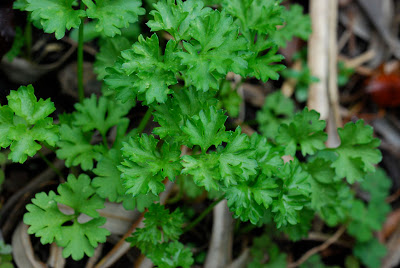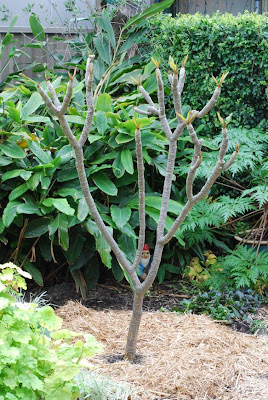Within the confined spaces of my little garden it's just not possible to put home-grown vegies on the table every meal. But with salads you can get pretty close to that ideal with everything in the salad bowl being home-grown, most of the time. It always feels nice to say "yes, all the greens are from our garden." And with the wonderful variety of salad greens that you can grow here in Sydney virtually all the time, this is one of the best backyard crops we can grow.
 Right now it's the delicious "anything grows" spring season. This is just a punnet of mixed lettuce sold as 'Combo', belting along nicely. I like this selection because of the variety of leaves it offers. Every now and then I don't get my act together with the seed-sowing routine, so I play rapid catch-up with a punnet of seedlings. Easy.
Right now it's the delicious "anything grows" spring season. This is just a punnet of mixed lettuce sold as 'Combo', belting along nicely. I like this selection because of the variety of leaves it offers. Every now and then I don't get my act together with the seed-sowing routine, so I play rapid catch-up with a punnet of seedlings. Easy. And over the other side of the path is an English spinach patch which has astonished me with its speed of growth. I wonder if the secret is that it's not in full sun? The leaves went from the crop of little 'baby' spinach leaves I had planned on adding to salads to rapidly becoming large, adult spinach leaves. Yet such has been the quick growth that the leaves are still soft and tender, and if torn-up a nice addition to a garden salad of mixed greens. The rest I'll harvest and cook soon enough.
And over the other side of the path is an English spinach patch which has astonished me with its speed of growth. I wonder if the secret is that it's not in full sun? The leaves went from the crop of little 'baby' spinach leaves I had planned on adding to salads to rapidly becoming large, adult spinach leaves. Yet such has been the quick growth that the leaves are still soft and tender, and if torn-up a nice addition to a garden salad of mixed greens. The rest I'll harvest and cook soon enough. And here are 'spillover' pots of spinach and lettuce that I couldn't find spots for anywhere else. I'm plundering these for fillings for sandwiches at lunchtime.
And here are 'spillover' pots of spinach and lettuce that I couldn't find spots for anywhere else. I'm plundering these for fillings for sandwiches at lunchtime. And here's the next generation of green and red lettuce seedlings popping up now. By the time they'll be ready to transplant some of the current crop will be past its best. I often get the timing wrong on these replacement crops, but sowing another batch at around monthly intervals is what works well most of the time.
And here's the next generation of green and red lettuce seedlings popping up now. By the time they'll be ready to transplant some of the current crop will be past its best. I often get the timing wrong on these replacement crops, but sowing another batch at around monthly intervals is what works well most of the time. One of the secrets of an interesting garden salad is a good variety of leaf shape, colour, flavour and texture. I find that a good selection of salad seeds can last a whole season or more, given the small crops that I sow. And the huge selection of seeds available gives you so much more variety than you can buy at the seedling section of the local nursery.
One of the secrets of an interesting garden salad is a good variety of leaf shape, colour, flavour and texture. I find that a good selection of salad seeds can last a whole season or more, given the small crops that I sow. And the huge selection of seeds available gives you so much more variety than you can buy at the seedling section of the local nursery. Here's a nifty bit of info I picked up courtesy of the Australian consumer magazine, Choice. They road-tested balsamic vinegars and this was their bargain best buy. It's less than $5 a bottle at our local Woolworths store.
Here's a nifty bit of info I picked up courtesy of the Australian consumer magazine, Choice. They road-tested balsamic vinegars and this was their bargain best buy. It's less than $5 a bottle at our local Woolworths store. The really valuable info from Choice is that there is an official rating system for balsamic vinegars run by the people in Modena, Italy, where the best balsamics come from. This is the back of the label. It says 'Consorzio Aceto Balsamico di Modena' and that shows that it's authentic Modena balsamic. Apparently, not every Modena balsamic maker is part of this rating organisation, but here in far-off Australia it's a handy thing to know about when you're browsing through a dozen different brands of balsamic vinegar and don't really know what to look for, apart from price.
The really valuable info from Choice is that there is an official rating system for balsamic vinegars run by the people in Modena, Italy, where the best balsamics come from. This is the back of the label. It says 'Consorzio Aceto Balsamico di Modena' and that shows that it's authentic Modena balsamic. Apparently, not every Modena balsamic maker is part of this rating organisation, but here in far-off Australia it's a handy thing to know about when you're browsing through a dozen different brands of balsamic vinegar and don't really know what to look for, apart from price. And this is the all-important 'leaf' rating symbol to also look for. Four leaves is the top rating they give for thick, sweet balsamic suitable for drizzling on strawberries or ice-cream. One leaf is for the thinner stuff that's fine for salad dressings. However, I've tried the different ones on offer and I always buy the four-leaf.
And this is the all-important 'leaf' rating symbol to also look for. Four leaves is the top rating they give for thick, sweet balsamic suitable for drizzling on strawberries or ice-cream. One leaf is for the thinner stuff that's fine for salad dressings. However, I've tried the different ones on offer and I always buy the four-leaf. The other thing I have learned recently is that one of the most important things in choosing a nice olive oil for a salad dressing is its freshness. In another recent road-test by Choice magazine, the local Australian olive oils scored very well in a blind taste test by experts, and they say the reason for this is freshness. Many moderately priced olive oils from Europe spend a long time in storage and transport before they ever make it to our supermarket shelves, and their flavour is often poor as a result. By comparison, the fresh local olive oils are often superior to the cheaper European oils because the local crop is this year's, not last year's.
The other thing I have learned recently is that one of the most important things in choosing a nice olive oil for a salad dressing is its freshness. In another recent road-test by Choice magazine, the local Australian olive oils scored very well in a blind taste test by experts, and they say the reason for this is freshness. Many moderately priced olive oils from Europe spend a long time in storage and transport before they ever make it to our supermarket shelves, and their flavour is often poor as a result. By comparison, the fresh local olive oils are often superior to the cheaper European oils because the local crop is this year's, not last year's. I haven't yet tried the Australian olive oil pictured here. It's a gift from my mother-in-law, after her recent driving holiday through olive oil growing districts of Australia. But mixed with some genuine Modena balsamic vinegar, I am sure it will do my home-grown salad leaves justice.











































